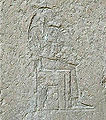Contents
The Vulture crown was an ancient Egyptian crown worn by Great Royal Wives and female pharaohs. It was depicted as a headdress in the shape of a vulture draped over the head, with its wings hanging down on the sides.[1] It was a symbol of protection associated with the vulture goddess Nekhbet, who often wore this crown when depicted in a human form.[2] These crowns were frequently worn by the Great Royal Wife, high ranking priestesses, and female pharaohs. These crowns were also sometimes equipped with the Uraeus to symbolize Wadjet,[3] representing both Upper (Nekhbet) and Lower Egypt (Wadjet).
History
The vulture crown was initially only seen in depictions of goddesses.[4] From the Fifth Dynasty onwards, however, queens began to wear the headdress regularly as part of their iconography.[5] The association of Nekhbet with the queen stemmed from the vulture's symbolism of motherhood; the hieroglyph for the vulture, mwt, was used to write the word for "mother".[6] Because Nekhbet was a protector goddess, the queen's affiliation with her complemented the king's role as the embodiment of the falcon god Horus.[7]
Khentkaus II was one of the first queens to wear the vulture headdress.[8] In the New Kingdom, the vulture's head on the crown was more frequently replaced by the uraeus.[9]
Gallery
-
A relief of Khentkaus I sitting on the throne with a faint Vulture crown, Fifth Dynasty, Pyramid of Khentkaus I, Giza
-
Ankhesenpepi II wearing a vulture crown while her son, the pharaoh Pepi II, sits on her lap. Sixth Dynasty (ca. 2288-2224 BCE), Egyptian alabaster, Brooklyn Museum
-
Stela of queen Nubkhaes of the Thirteenth Dynasty in which she is depicted giving offerings to Hathor and Osiris, Louvre Museum, Paris
-
Stela honoring Tetisheri, grandmother of Ahmose I, from Abydos. Eighteenth Dynasty, Egyptian Museum in Cairo
-
Sketch of a painting from a tomb in Sheikh Abd el-Qurna depicting Merytre-Hatshepsut with her husband Thutmose III, Eighteenth Dynasty
-
Nefertari, wife of Ramesses II, wearing a vulture crown along with plumes and a sun disk, Nineteenth Dynasty (c. 1255 BCE), QV66, Valley of the Queens, Luxor
-
Nodjmet, wife of the High Priest of Amun Herihor, wearing a vulture crown. Book of the Dead of Nodjmet, Twenty-first Dynasty (c. 1064 BCE)
-
The goddesses Wadjet and Nekhbet wearing Vulture crowns along with the Deshret and Hedjet respectively while crowning Ptolemy XIII, Ptolemaic period, Temple of Edfu
References
- ^ Graves-Brown, Carolyn, Dancing for Hathor: Women in Ancient Egypt, Contiuum 2010, p. 131
- ^ Robins, Gay, The Art of Ancient Egypt, Harvard University Press 1997, p. 67
- ^ Capel, Anne K.; Markoe, Glenn, Mistress of the House, Mistress of Heaven: Women in Ancient Egypt, Hudson Hills Press with Cincinnati Art Museum 1996, p. 139
- ^ Vassilika, Eleni, Ptolemaic Philae, Uitgeverij Peeters 1989, p. 93
- ^ Redford, Donald B., The Oxford Encyclopedia of Ancient Egypt: P-Z, Oxford Univ Pr (Sd) 2001, p. 106
- ^ Lesko, Barbara S., The Great Goddesses of Egypt, OUP 1999, p. 66
- ^ Benard, Elisabeth; Moon, Beverly, Goddesses Who Rule, Oxford University Press 2000, p. 216
- ^ Budin, Stephanie Lynn, Images of Woman and Child from the Bronze Age: Reconsidering Fertility, Maternity, And Gender In The Ancient World, Cambridge University Press 2014, p. 47
- ^ Fischer, Henry George, Egyptian Studies III Varia Nova, Metropolitan Museum of Art 1996, p. 116










